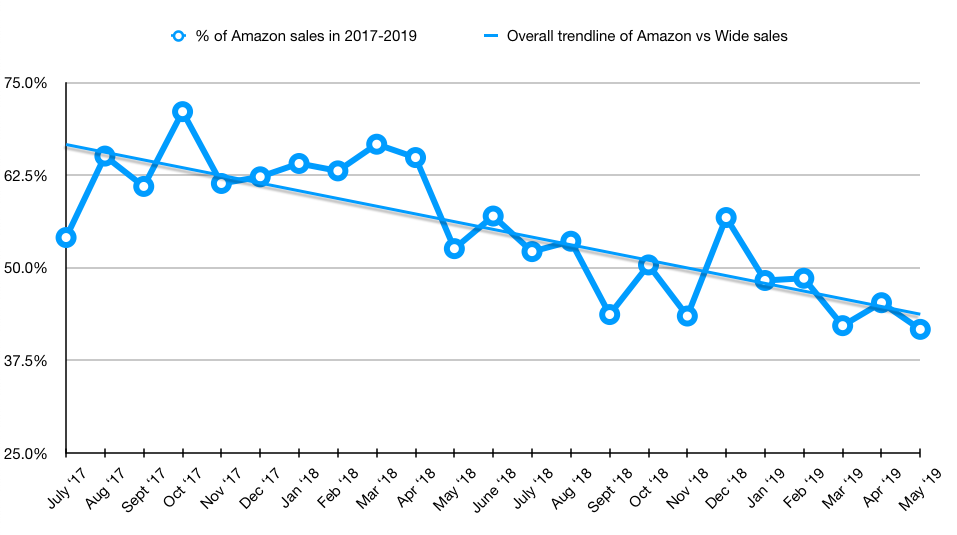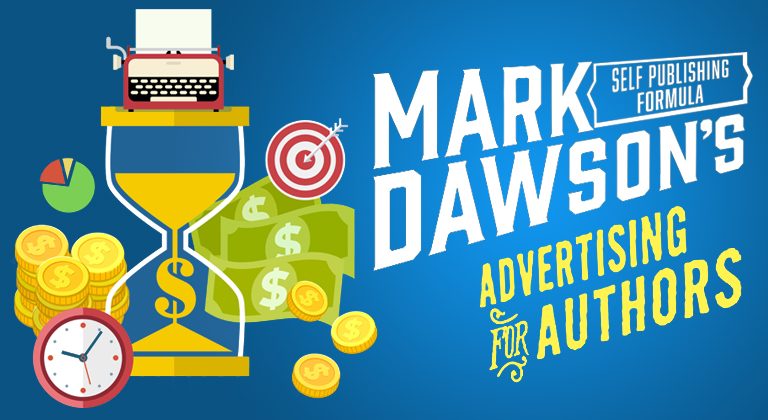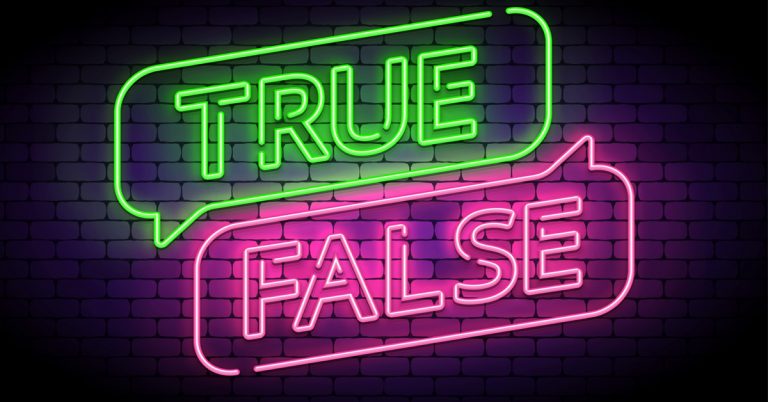Top 10 Tips to Going Wide
We’ve been hearing from more and more authors lately that are cutting the cord, so to speak – stepping away from KU exclusivity for one reason or another in order to test the waters by “going wide”, which simply means selling their book across all (or most) of the digital storefronts instead of just Amazon. Erin Wright went wide back in 2016 and has never looked back, which is why she’s perfectly suited to provide you with the tips for how to change your way of Amazon-centric thinking and prepare to bring your work to a much wider audience.
Howdy, y’all! *waving* I’m Erin Wright, a USA Today bestselling author. I write contemporary western romance, and am a dedicated wide author. Although I didn’t start out as a wide author, I quickly became one as Amazon went through one upheaval after another, stripping page reads from authors, shutting down accounts without warning, and in general being the massive gorilla in the room, willing and able to stomp any author’s career to pieces at the drop of a hat. Being completely dependent on them seemed like the quick road to insanity, so I went wide at the end of 2016 and haven’t looked back since.
One quick graph just so you can be sure that I know what I’m talking about, and then we’ll dive into some tips:

This graph shows Amazon’s percentage of my overall income. As you can see, it started out fairly high but over time, it’s been slowly but surely dropping, until now, a little less than half of my income comes from Amazon. I am the primary breadwinner in my family, and I don’t have another source of income – writing is how I support my family. So I’m not making $300 a month and telling you how you should also. I’m making a living wage doing this, and without a single page read to my name for a couple of years now.
Ready to learn how? Let’s go!
1. Stop jumping in and out of KU…
…like a kangaroo hopped up on sugar. You might think that this will help you increase your sales or page reads or whatever, but what it ends up doing is making everyone upset with you. KU readers get used to getting your books via KU and are now upset that they can’t every time you pull them to go wide. Wide readers get used to being able to buy your books on their preferred storefront and are now upset that they can’t every time you pull them and go into KU. Wide storefronts take one look at your record (in, out, in, out) and wonder why they should waste their precious audience on you, and instead pick another author to promote in-house who’s been consistently wide for years. (And if you think they aren’t paying attention to things like that, you’re deluding yourself. They absolutely do. Amazon and Google Play don’t, but Apple, Kobo, and B&N do. It plays a significant part in their decisions of which authors to include in their in-house promos).
Pick a lane and stick in it, for at least a year if not for the rest of eternity. You’ll be soooo much better off for it, promise.
2. Stop giving away Amazon gift cards or Kindle eReaders
When you give away prizes, give away prizes that work for ALL storefronts, not just Amazon. When I give away gift cards (I give away a $15 gift card every single week in my newsletter), I let my readers choose from any of the five major storefronts (Amazon, Apple, Barnes & Noble, Google Play, or Kobo). This tells my wide readers that they matter. Instead of saying, “You only count if you get your books from Amazon,” you’re saying, “Every one of my readers matters to me, and that means you too, Google Play reader.” This makes a difference to them, I promise, and it also makes a difference to the wide storefronts. Again, do you think they don’t notice when you run a big promo on Facebook and the grand prize is a $500 gift card to Amazon? I promise they do, and the next time they go to pick an author for a specific promo, are they going to pick you? I doubt it.
Oh, and I only give away iPads, NOOKs, or Kobos when I give away an eReader as a prize. I never give away a Kindle. There are enough Kindles in the world. I don’t need to add to the number.
(If you’re curious about my weekly drawing for prizes that I include in my newsletter, here’s a random newsletter of mine. Scroll down to the bottom where I announce that week’s winner, and also link to the survey online so people who haven’t taken it before can take it, which will enter them into the drawing from there forward. Any submission to the survey by someone who isn’t subscribed to my newsletter will automatically get discarded, and ONLY the people who open and scroll down to the bottom of each newsletter can win. It’s quite simple – the US winner of the week simply has to hit reply to claim their gift card. I ask them which storefront they shop on; they tell me; I send them a $15 gift card for that storefront. For international readers, all of the same applies but they’re choosing an ebook of mine to win as their prize. I use BookFunnel to deliver their prize to them. All in all, a cheap way to ensure that my readers are reading my newsletters every week while also working no matter which storefront a reader prefers).
3. Stop advertising in paid newsletters that only include Amazon links
(This is one of the reasons why I love Hidden Gems, by the way! They’re one of the “good guys,” who link to ALL storefronts, not just Amazon. I’ve been using Hidden Gems as a way to reach new readers for years now, and have never been disappointed by their results).
I’ve actually unsubscribed from author newsletters from paid newsletter companies where they only link to Amazon, and dropped them a quick note before I did so, explaining why I was unsubscribing. I will no longer pay for an advertisement in a newsletter where they only link to Amazon. Period. I’ve also emailed companies that link to multiple storefronts, and have told them that I appreciate that, and that I pay attention to that fact. If they’re reconsidering this policy in the future, I want them to know that I’m specifically using them because they allow me to link to all storefronts, and maybe this will cause them to choose to keep in the links to all storefronts. It doesn’t hurt, anyway.
4. Stop linking to just Amazon…
…on Facebook, in the description of a book trailer on YouTube, or on any other social media platform. People get frustrated by looking at an ad for a book and thinking, “Hey, that looks great!” and then when they click, they’re brought straight to Amazon. This means that either they take the time to look the book up on their preferred storefront (not likely) or they just click away, that sale lost forever. Stop making your wide readers work harder to make a purchase than Amazon readers have to.
5. Stop buying your books on Amazon
I know this sounds slightly insane, but it can be done, I promise. This has all SORTS of bennies connected to it: You’re no longer supporting an entity with your dollars that is actively hurting authors every day, and you’re using another storefront regularly, which means that you learn how that storefront works. Instead of only paying attention to how Amazon works, you’re learning the bestseller charts of the other storefronts. You’re learning their marketing strategies. You’re learning how their search engine works. All of this gives you an edge when it comes to gaining new readers on that platform.
If moving your business to another storefront seems just this side of nuts and there’s simply no way you’d be willing to do it, at least take the step of cancelling KU. Cancel Prime. Quit your Audible subscription. Stop supporting Amazon through subscriptions to their services. I used to have KU, Prime, and Audible credits every month. I now have none of them.
It can be done.
6. Stop cross-promoting with other authors who are KU exclusive
Everyone knows it: KU readers are not loyal. If a reader found you through KU and then you stop offering your books through that program, they won’t start buying your books, at least not at the $4.99 price point. They might buy your books if you run them on a super sale but otherwise, they’re dead weight on your newsletter list. Not all subscribers are created equal, and you only want the ones who are willing to pay the higher prices. Not to mention that if you promote an author in your newsletter who is in KU, you’re telling your wide readers once again that they don’t matter. I will not advertise an author in my newsletter who is exclusive. Period. I don’t care how good of a friend that author is. I just won’t do it. I refuse to tell my wide readers that they aren’t worth thinking or worrying about.
7. Stop targeting KU authors in your ads
Again, this brings in the wrong audience. Only ever target wide authors. I will target someone who has part of their books in KU and part of them wide, but never someone who is all in with KU. This is true no matter what platform I’m advertising on (Facebook, AMS, or BookBub ads).
8. Stop spending money on AMS ads
Try not to have a heart attack with this one, lol – I’m being serious. Use Facebook or BookBub ads. They both allow you to target a wide audience. I get Amazon clicks; I get wide storefront clicks. I get them all. Instead of spending my money to grow my audience on one specific storefront (a storefront I personally cannot stand), I spend my money growing my audience on all storefronts.
9. Stop having an ARC team that only reviews on Amazon
As a wide author, you want reviews everywhere. Readers on Barnes & Noble or Google Play want to know that your book is awesome before they click “Buy,” just as much as a reader on Amazon wants to know this. When I add new readers to my ARC team, I will only add readers who will review on at least two storefronts (and it can be any two storefronts that they want. They can review on Apple Books and Kobo. Or Amazon and Google Play. Whatever combination works for them). If a reader currently only gets their books from Amazon, that’s okay. It’s free to set up an account on all other storefronts (although do bear in mind that you need an Apple ID to review on Apple Books). But none of the other storefronts have a $50 minimum purchase amount before people can review there, like Amazon does. So I tell potential ARC readers to pick another storefront, set up a free account there, and review. I don’t care which one, but they do have to pick one.
And later on, if that reader is thinking about switching away from Amazon and to a new storefront, do you think they’ll be more likely to pick that secondary storefront? You betcha. They’ve spent months or even years at that point, writing reviews on it. That increased comfort level will play a big part in their choice.
10. Stop trying to learn from authors who are KU exclusive
There are authors who choose to teach classes, run Facebook groups, or even write books to help their fellow authors, and they have their own biases, just like everyone else. They might say that their books (or classes or groups) are applicable to all authors but the strategies for success on wide storefronts is so diametrically different from succeeding on Amazon that this is quite literally not possible. Stop reading or learning from sources that are focused on the wrong thing. It’s like trying to learn how to become a vegetarian by taking a paleo cooking class. It’s just not gonna work.
If you can’t tell, being wide is as much of a mental shift as anything else. It simply isn’t enough to throw your books up on wide storefronts and call it good. If you’re putting your books up on all storefronts but otherwise running AMS ads, giving away Kindle eReaders, linking to Amazon in social media posts or in your newsletters, and collaborating with a bunch of other KU authors…Well, don’t be surprised when your wide sales never really take off.
One Last Thought
Wide sales take a long time to build up, at least compared to Amazon. But they also take a long time to die down, at least compared to Amazon. Amazon is your bipolar friend – a lot of fun when they’re up and a whole lot of no fun at all when they’re down. Wide sales will stay a lot more steady over the long-term, although of course they also go up and down. The swings simply aren’t as wild (in EITHER direction!) So when your sales are slow to take off on wide storefronts, keep plugging away. Make sure that you’re wide in more than just name, and don’t give up after a week or a month of poor sales. The sales will come, I promise…as long as you actually follow the tips outlined above.
I hope this helped! If you’d like to start collaborating and learning from other authors who are also wide, be sure to check out the Facebook group Wide for the Win. We have over a thousand authors in our group now, and we’re getting bigger by the day. We’ve also got reps from a wide variety of companies that are on-hand if you have questions, including D2D, Smashwords, Hidden Gems (of course!), IngramSpark, Google Play, and lots more! We’re the largest wide-centric group on Facebook, but there’s always room for more, I promise. 😉
Have tips or thoughts of your own on how to succeed as wide author? Leave ‘em below!












I’m still learning but I made a promise to myself at the beginning of this hours that I wanted nothing to do with Amazon. I write children’s books and want the child to hold the actual book in their hands so no electronic books for me. I know this limits me but I’m staying true to myself. Thank you for this wonderful article. I’ll try to sort out all the different options. Lisa
Thanks for this informative article, Erin. I’ve been wide for about two years.
Quick question: When you advertise on Facebook, do you target a landing page on your own website with links to all storefronts, or do you use an service like Books2Read that provides a landing page with wide storefront links?
With thanks,
Lee
@Lee – I’ve seen this done both ways. I’ll be honest – I am totally not the queen of Facebook ads. My best suggestion would be to join the Wide for the Win FB group (if you haven’t already) and ask in there. There are LOTS of really smart authors in the group who’d love to help you out. ❤️ Good luck!
Thanks Erin. I am a member of that group, so I’ll pose that question there.
With thanks,
Lee
Thank you for a provocative perspective. I’ve learned three things ( the hard way) this year. 1) When you decide you want to earn a living from your books, paid advertising becomes a necessity. 2) It doesn’t make financial sense to advertise on platforms like Facebook, bookbub etc, and only have your books in KU. 3) When I run Amazon ads, my sales seem to dry up and I only get page reads, which cuts my income by about 50% per book. Therefore, my next standalone will be released wide. If it goes well, I will likely continue along that path. Thanks for the tips about ARC readers. I was going to email mine today, but I think I’ll include a survey of other platforms they are on. Cheers,
@Annabeth – oh, that’s fascinating that you make so much less when you’re in KU bc of the difference in page reads vs sales. And just think – if you’re wide, you’ll also be able to make money on the other storefronts too!
The last time I did the math, I figured out that I make ~45% of my income from Amazon and ~55% from wide storefronts. As you can see in the graph at the start of the article, it’s taken me a while to get to those numbers, so this isn’t an overnight thing. But this means that if I were to go into KU, I’d lose 55% of my income right off the bat and then even more after that when people stopped purchasing my books and instead read them via KU (like what’s happened to you).
With that in mind, it’s not hard for me to choose to stay wide!
I hope you choose to join our FB group. There are a LOT of KU-exclusive authors who are moving wide right now, so you’d have a great support group to help you make the transition.
Good luck! 🍀
As an author who refuses to play the “KU vs Wide” game, I have some of my books exclusive to KU and some of my books wide. I switch out a few times a year. I refuse to alienate an audience just because I don’t like the company that provides the books (in this case, with Erin Wright, she seems to hate Amazon).
I’m always looking for tips to market my books either in KU or wide, but this piece left a bad taste in my mouth. I understand not liking Amazon because of actions they’ve done (hence why I’ll never be all in KU) but some of the things in this article seem quite negative.
And when Erin Wright wrote that KU readers weren’t loyal, that’s where she’s wrong. I have lots of KU readers that go out and buy my new releases that are wide. Just as I have wide readers that go out and buy my KU reads. And yes, I have tested that, I am not just saying it.
I will never be all wide or all KU. As I said, I don’t play that us vs them game.
@Elizabeth – thanks for your perspective. I do tend to be negative towards Amazon because of the destruction I’ve seen them wreak on author’s careers. I’m lucky that they haven’t ever shut my account down, but I’ve seen it happen to other authors, and my heart hurts for them.
However, there are a lot of people who love Amazon, and there are reasons TO love Amazon. What worries me most about them is the potential to be a monopoly. Monopolies scare me, and Amazon’s viewpoint on exclusivity and KU makes me Very Nervous.
That’s just me, and of course you’re welcome to disagree!
I am fascinated by the fact that you find KU readers to be loyal. I am not exaggerating in the slightest when I say that you are literally the one and only author I’ve ever heard say that. In 4+ years of being in this business, that is literally a first for me. Every other author who has moved out of KU and into wide has complained about how the platform and readership that they built while in KU hasn’t followed them wide, and they are starting over from Ground Zero.
With your comment, I’m seeing that there are exceptions to this; you should feel very special. As far as I can tell, you are literally one in a million. Keep doing what you’re doing since it’s working for you!
Good luck! 🍀
Newsflash: publishing wide is not a personality trait and I for one am sick of the wide virtue signalling.